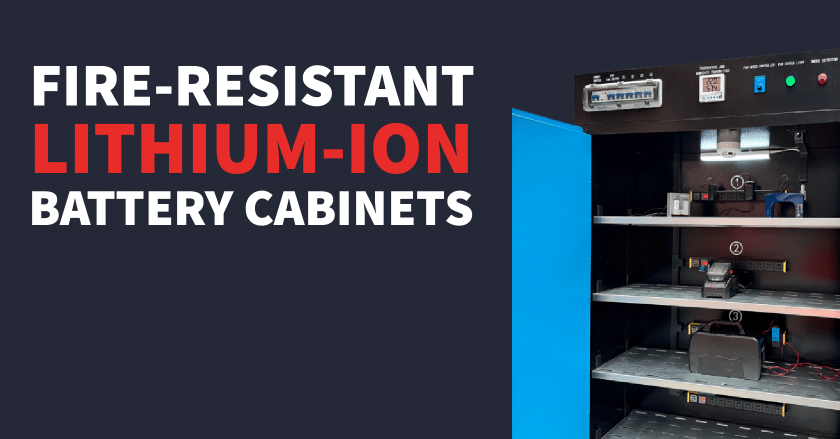No products in the cart.
Lithium-ion Battery Cabinets – Engineered for High-Risk Battery Storage
Compliant. Fire-resistant. Ready for NZ conditions.
As lithium-ion batteries become standard across power tools, plant, transport, and storage systems, the risk of fire from thermal runaway increases. Whether from impact, overcharging, or internal fault, even small battery packs can pose a significant hazard — especially when stored in bulk.
Our Lithium-ion Battery Cabinets are designed to minimise this risk through controlled, ventilated and secure containment. Built to meet the demands of busy industrial and commercial environments, they provide peace of mind for any business working with rechargeable battery tech.

Fire-Resistant Lithium-ion Battery Cabinet Features (AS/NZS 5139 Compliant)
- Double-Walled Steel Construction: Heavy-duty powder-coated finish with 40mm insulating air gap — slows heat transfer in fire conditions.
- Self-Closing, Lockable Doors: Complies with workplace safety standards. Door remains closed when not in use to reduce fire spread risk.
- Adjustable Galvanised Shelving: Easily position shelves to accommodate tools, charging racks, or battery trays. Optional bunding trays available.
- Natural Ventilation Ports: Dual ports allow for passive airflow or connection to mechanical ventilation, depending on site requirements.
- Static Earth Lug: Reduces risk of static discharge in dry environments — a key consideration for lithium storage.
Where to Use Lithium-ion Battery Cabinets
These cabinets are designed for any environment where lithium-ion batteries are charged, stored, or cycled regularly. Typical applications include:
Battery Types Commonly Stored
- Power tool batteries (e.g. 18V, 36V systems)
- E-bike and mobility scooter batteries
- Drone, UAV, and robotics battery packs
- Solar battery modules awaiting install
- Damaged, returned, or end-of-life batteries awaiting disposal
Industries & Work Environments
- Construction sites – tool battery storage & charging room segregation
- Warehouses and logistics depots – safe containment during goods-in
- Maintenance workshops – charged/uncharged battery separation
- Facility management – backup battery safety
- Fire & emergency services – returned battery containment
- Renewable energy installers – solar battery staging
When Should You Use One?
- When storing batteries overnight or unattended
- When charging multiple devices in one location
- When isolating damaged or suspect battery units
- When required by site risk assessments or insurer guidelines
Available Options
Standard Lithium-ion Battery Cabinet
- Ideal for smaller volume sites or portable use
- Compact footprint fits into site rooms or tool stores
Heavy Duty Lithium-ion Battery Cabinet
- Reinforced design with greater internal volume
- Suitable for high-turnover storage or larger format batteries
- Optional internal bunding tray for liquid containment
Compliance & Safe Handling Guidelines
Standards Supported
- AS/NZS 5139 – Electrical installations and safety of battery energy storage systems (BESS). Helps you manage risks associated with lithium-ion battery fires, especially in non-domestic environments.
- AS 1940 – Storage and handling of flammable and combustible liquids. Relevant where batteries are stored near other hazardous substances or in multi-risk environments.
- AS 3780 – The storage and handling of corrosive substances. Applicable for mixed-use facilities, especially if corrosive charging fluids or electrolyte leakage are present.
Fire & Safety Considerations
- Cabinets are fire-resistant, not fireproof vaults. They provide containment and thermal delay, not active suppression.
- Always position cabinets away from direct ignition sources or high-heat equipment.
- If charging batteries inside the cabinet, ensure ventilation ports are not obstructed.
- Consider using fire detection or suppression systems in high-risk areas.
Handling Best Practices
- Use shelving to separate batteries by type, size, or state of charge.
- Store damaged or swollen batteries in dedicated trays or flameproof bags inside the cabinet.
- Ground the unit using the static earth lug if required by site conditions.
- Include cabinets in your site risk assessment and emergency response plan.
Ready to Deliver Nationwide
Available now from our NZ warehouse. Speak to our team about volume discounts or specialist applications.
